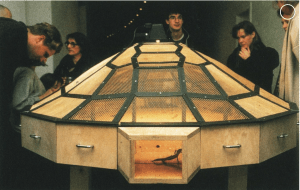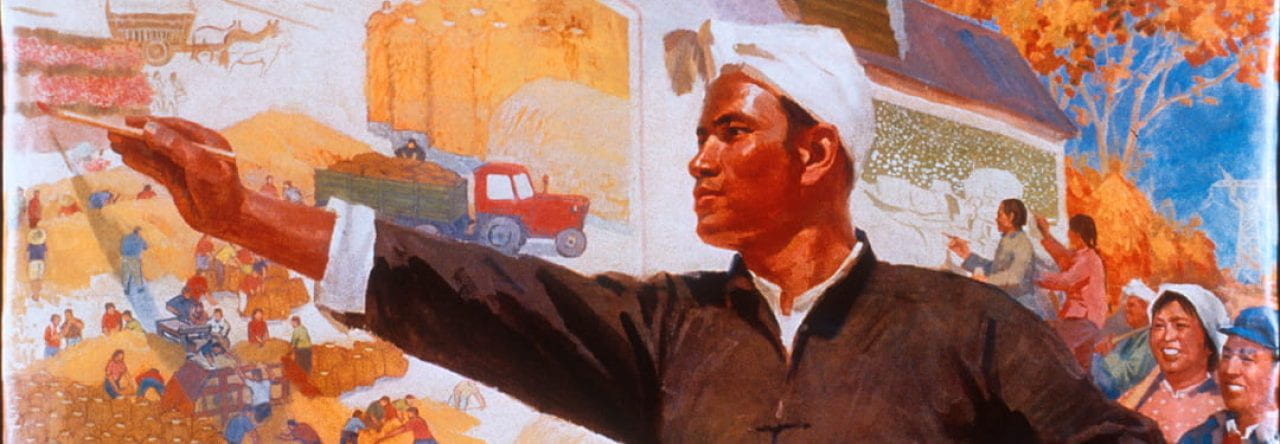
The installation shown below is called “Theater of the World” done by Huang Yongping in 1993. The installation includes two main structures: first the arching metal frame that bridges over the second structure, a wooden four legged table with a transparent octagonal wire mesh cage on top of it (Jiang Zhi, “christies.com”, 2017). In the original piece the bridging structure housed snakes and turtles together, while the cage below was equipped with heating lamps, and housed live spiders, scorpions, crickets, cockroaches, black beetles, stick insects, centipedes, lizards, toads, and snakes (“publicdelivery.com”, 2022). Naturally housing all of these different species together led to some of them eating one another. This led to international outrage as animal rights activists gathered over 800,000 signatures to remove the work, and were actively protesting before the works installation in New York threatening violent retaliation if installment was not halted (“publicdelivery.com”, 2022). This public pressure forced organizers to remove Yongping’s installation along with two other pieces from Guggenheim’s new exhibition of contemporary Chinese art, Art and China after 1989: Theater of the World (Jiang Zhi, “christies.com”, 2017). The organizers decision to remove the work from the exhibition due to threats of violence is extremely ironic. Through his work Huang was attempting to highlight humanity’s natural propensity to turn to violence, especially during this time period where the world is feeling the aftermath of the World Wars, and the Cold War (Jiang Zhi, “christies.com”, 2017). Huang wanted to show the world a completely natural, raw, and uncensored version of how animals survive in nature. Having the installment completely transparent as well allowed his audience to observe the animals in their natural form attacking one another to see first hand just how cruel nature can be. This was done purposely to draw on the long history of war, oppression and poverty not just in China, but the rest of the world as well (Jiang Zhi, “christies.com”, 2017). In a way Huang is attempting to illustrate that the cultural, and political divide between the east and the west boils down to humanity’s natural tendency to commit violent acts.
Biography:
- “Huang Yong Ping’s Controversial Theater of the World – Public Delivery.” 2022. Publicdelivery.org. April 14, 2022. https://publicdelivery.org/huang-yong-ping-theater/#Who_was_Huang_Yong_Ping. (“publicdelivery.com”, 2022)
- “Theater of the World and the Bridge by Huang Yong Ping.” 2017. The Guggenheim Museums and Foundation. October 6, 2017. https://www.guggenheim.org/audio/track/theater-of-the-world-and-the-bridge-by-huang-yong-ping.
- Zhi, Jiang. 2017. “Eyes Wide Open: How Chinese Contemporary Art Went Global | Christie’s.” Www.christies.com. 2017. (“publicdelivery.com”, 2022)https://www.christies.com/features/Art-and-China-after-1989-Theater-of-the-World-8579-1.aspx. (Jiang Zhi, “christies.com”, 2017)



Kewen Li
I’m interested in your post, especially how the artist uses installation art to convey a particular idea. Huang’s artwork is different from what I have studied about Feng Zikai’s work because Huang’s work was set in a three-dimension space. I think that this kind of art could bring a novelty to its audience compared to the art placed on a flat surface. Moreover, you have mentioned the interaction between the artist’s work and the outside community (e.g. how the animal rights activists held the protest against the work). It raises my curiosity about how the artist’s work influences the external world and the community.
Aram Festekjian
Joseph’s visual analysis of Huang Yong Ping’s Theater of the World is interesting mainly because people forget how cruel nature can truly be. I find it fascinating that Huang Yong Ping created an art installment to compare humans to wild animals. The installation showcases the natural tendency of committing violence to survive. Even though humans are more conscious of violence, It still demonstrates humans’ natural tendency to be vicious. This installment shows that violence is necessary to survive within the world of animals. However, this installment allows viewers to understand that humans can not be like animals and must be more logical and considerate before causing destruction. Huang Yong Ping created this artwork for people to take a step back and visualize that not everything needs to be determined through violence.